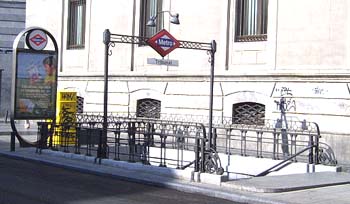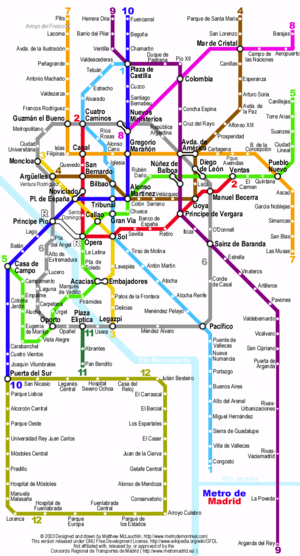Madrid Metro
|
|
Missing image Madrid-metro-2.jpg A modern metro train (type 8000) on line 8 at Colombia station |
The Madrid Metro is the large metro system serving Madrid, the capital of Spain.
It is one of the largest metro systems in the world, which is especially remarkable considering Madrid's population of approximately four million. In fact, it's among the top 10 longest metros in the world, though Madrid is approximately the fiftieth most populous metropolitan area in the world. It is also one of the fastest growing in the world, rivalled only by the Seoul Metro (Seoul); the latest round of expansions, completed in spring 2003, have increased its length to 227 kilometres. An additional 44 km of metro lines are expected to be constructed by 2007, as well as 30 km of light rail lines that will serve the western region of the metropolitan area.
The metro opened in 1919 under the direction of the Compañía de Metro Alfonso XIII. Metro stations served as air raid shelters during the Spanish Civil War.
Starting in the 1970s, it was sequentially greatly expanded to cope with the influx of population and urban sprawl from Madrid's economic ascendancy. A huge project in the late 1990s and early 2000s installed approximately 50 kilometres of new metro tunnels, including a direct connection between downtown Madrid and Barajas International Airport (line 8), and service to outlying areas, including a huge 40-kilometre loop called MetroSur (line 12) serving Madrid's southern suburbs.
MetroSur, the largest civil engineering project in Europe, opened on April 11, 2003. It includes 40.7 kilometres of tunnel and 28 new stations (including an interchange station and an additional station on Line 10, which connects it to downtown). Construction began in June 2000, the whole loop was completed in less than three years. It connects the towns of Getafe, Móstoles, Alcorcón, Fuenlabrada, and Leganés.
Madrid also has an extensive commuter train (Cercanías) network operated by Renfe, the national rail line, which is intermodal with the metro network. Several Cercanías transfer stations were included in MetroSur.
Madrid's metro consists of the following lines: (see also List of Madrid metro stations)
| Line | Length | Stations | Section | Platform | |
| 1 | Plaza de Castilla – Congosto
| 16.7 km | 27 | narrow | 90 m |
| 2 | Ventas – Cuatro Caminos
| 7.9 km | 15 | narrow | 60 m |
| 3 | Legazpi – Moncloa
| 6.4 km | 10 | narrow | 60 m |
| 4 | Argüelles – Parque de Santa María
| 12.8 km | 20 | narrow | 60 m |
| 5 | Canillejas – Casa de Campo
| 20.8 km | 30 | narrow | 115 m |
| 6 | Circular
| 23.5 km | 27 | wide | 115 m |
| 7 | Las Musas – Pitis
| 18.8 km | 22 | wide | 115 m |
| 8 | Nuevos Ministerios – Barajas
| 13.9 km | 6 | wide | 115 m |
| 9 * | Herrera Oria – Arganda del Rey
| 20 + 18 km | 22 + 4 | wide | 115 m |
| 10 | Fuencarral – Puerta del Sur
| 24 km | 19 | wide | 115 m |
| 11 | Plaza Elíptica – Pan Bendito
| 2.3 km | 3 | wide | 115 m |
| 12 | MetroSur
| 41 km (circular) | 27 | wide | 115 m |
| R ** | Ópera – Príncipe Pío
| 1.1 km | 2 | narrow | 60 m |
Notes:
* Includes light rail from Puerta de Arganda to Arganda del Rey (18 km, 4 stations)
** For Ramal, "branch"
The metro is operated by its own company, under the Department of Public Works, City Planning, and Transportation of the autonomous community of Madrid. All of Madrid's rapid transit systems are members of the Consorcio Regional de Transportes, which sells monthly passes for unlimited use of the metro, bus and commuter train networks within the area covered by the pass.
External links
- Metro de Madrid (official site, in Spanish, English language available via selection box) (http://www.metromadrid.es/)
- UrbanRail.net/Madrid (http://www.urbanrail.net/eu/mad/madrid.htm)
- Consorcio Regional de Transportes de Madrid (http://www.ctm-madrid.es/)


